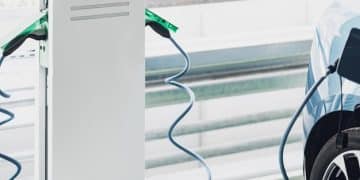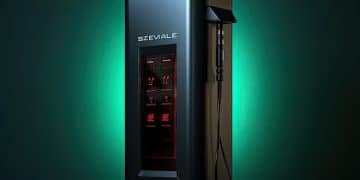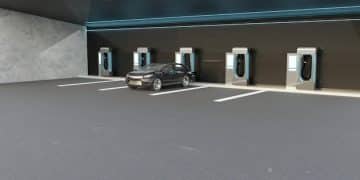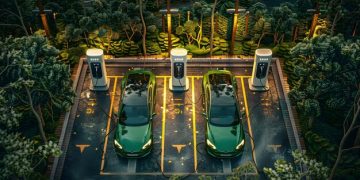Federal EV Charging Standards 2025: NACS Adoption Insights
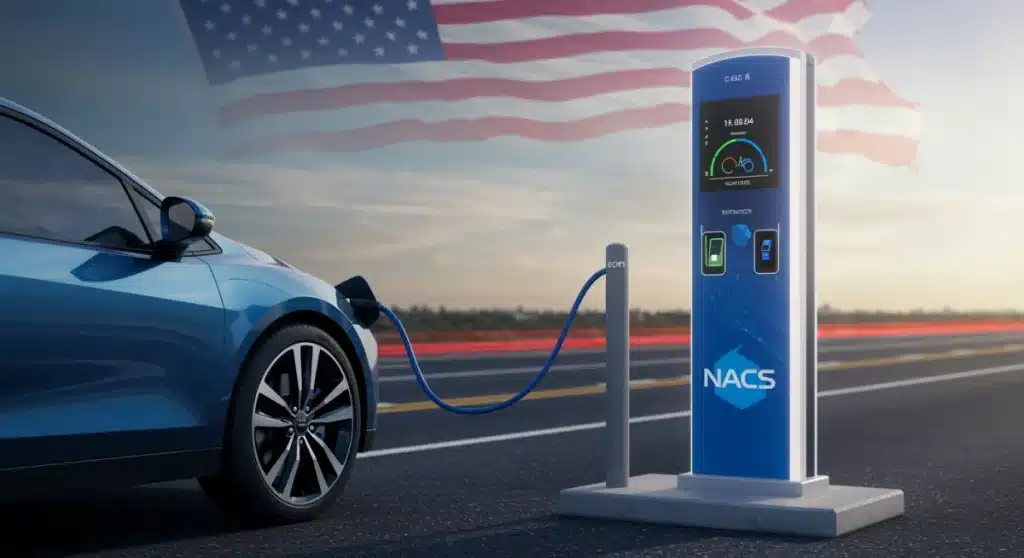
The new Federal EV Charging Standards for 2025 mandate NACS adoption, fundamentally reshaping the US electric vehicle charging landscape and offering enhanced interoperability and convenience for drivers nationwide.
The landscape of electric vehicle (EV) charging in the United States is on the cusp of a significant transformation. With the impending implementation of new Federal EV Charging Standards for 2025, particularly the widespread adoption of the North American Charging Standard (NACS), drivers are about to experience a more streamlined and efficient charging ecosystem. This shift marks a pivotal moment for EV infrastructure, promising greater compatibility and accessibility across the nation.
Understanding the Shift to NACS: A New Era for EV Charging
The move towards the North American Charging Standard (NACS) as a federal benchmark for electric vehicle charging is a monumental step for the industry. For years, EV drivers have navigated a fragmented charging landscape, often encountering different connector types and varying levels of reliability. NACS aims to unify this experience, offering a single, widely recognized standard that promises to simplify charging for everyone.
This shift isn’t merely a technicality; it’s a strategic move to accelerate EV adoption. By reducing complexity and increasing charging consistency, the government hopes to alleviate range anxiety and make electric vehicles a more attractive option for a broader segment of the population. The standardization will also foster innovation and competition among charging network providers, ultimately benefiting consumers.
The Legacy of CCS and Tesla’s Pioneering Role
- CCS Dominance: For a long time, the Combined Charging System (CCS) was the prevailing standard for non-Tesla EVs in North America, supported by most major automakers.
- Tesla’s Proprietary Network: Tesla, however, developed its own highly successful and extensive Supercharger network using its proprietary connector, which later became known as NACS.
- Performance and Reliability: Tesla’s network was often lauded for its reliability, speed, and user experience, setting a high bar for the industry.
The decision to adopt NACS federally acknowledges Tesla’s pioneering work in developing a robust and efficient charging solution. This transition will require significant investment and adaptation from other automakers and charging infrastructure companies, but the long-term benefits of a unified standard are expected to outweigh the initial challenges.
Why NACS Adoption Matters for Drivers
For the average EV driver, NACS adoption means an end to the confusion of different connectors and adapters. Imagine pulling up to any charging station, regardless of brand, and knowing your vehicle will connect seamlessly. This convenience is paramount to making EVs a truly mainstream mode of transport. It also means potentially more charging options available, as stations transition to support the new standard.
Furthermore, this standardization could lead to more competitive pricing for charging services and improved maintenance across the network, as resources can be focused on a single technology. The unified approach offers a clear path for future technological advancements, ensuring that charging infrastructure keeps pace with evolving EV battery technology.
In essence, the move to NACS represents a maturation of the EV industry. It signals a collective effort to build a more user-friendly and robust charging ecosystem, crucial for the continued growth and success of electric vehicles in the United States.
The Timeline to 2025: Key Milestones and Implementation
The journey to full NACS adoption by 2025 involves a series of critical milestones and strategic implementations. This is not an overnight switch but a carefully orchestrated transition designed to minimize disruption while maximizing future benefits. Both the government and private sector players have crucial roles in ensuring a smooth rollout.
Understanding this timeline is essential for both current and prospective EV owners. It helps set expectations for when new charging options will become widely available and when older infrastructure might begin to phase out or adapt. The goal is a seamless shift that enhances the EV driving experience without leaving anyone behind.
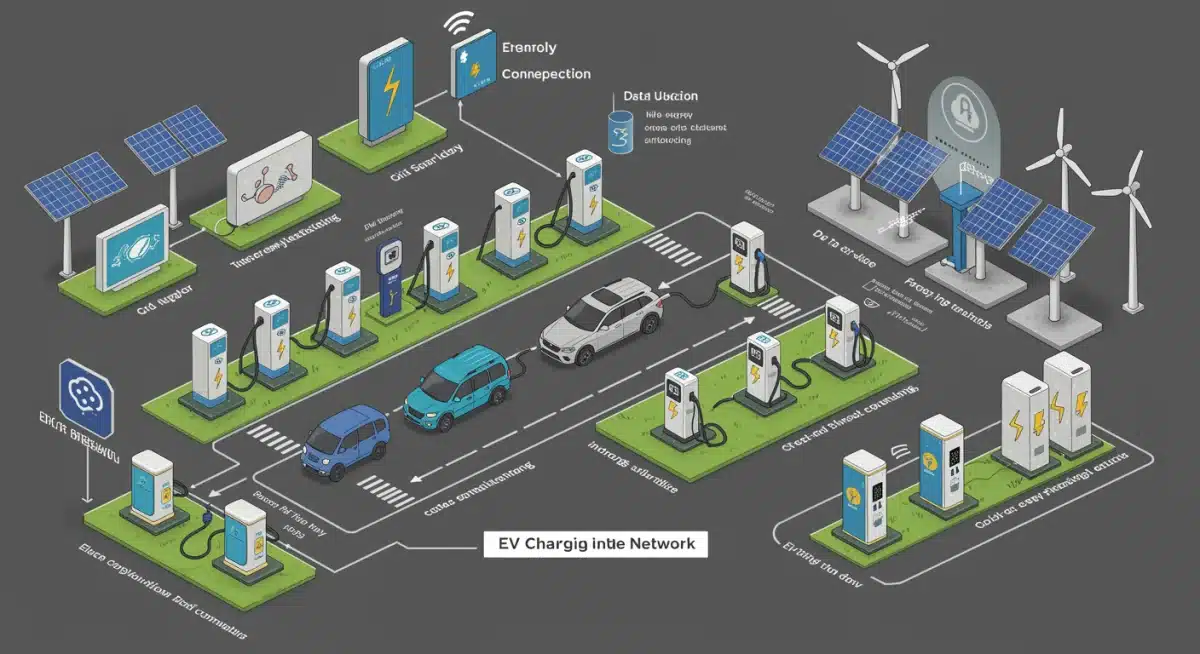
The federal government is leveraging funding and regulatory incentives to accelerate this transition. This includes requirements for publicly funded charging stations to incorporate NACS connectors, ensuring that new infrastructure built with taxpayer money is future-proofed and universally accessible to NACS-equipped vehicles or those with adapters.
Automaker Commitments and Transition Strategies
- Major Manufacturer Endorsement: Numerous prominent automakers, including Ford, GM, Rivian, and others, have already announced their plans to integrate NACS ports into their future EV models.
- Adapter Solutions: For existing EVs with CCS ports, many manufacturers are planning to offer adapters, allowing these vehicles to access the NACS Supercharger network and other NACS-equipped stations.
- Phased Rollout: The integration of NACS will likely be a phased rollout, with new models featuring native NACS ports appearing first, followed by adapter availability and broader infrastructure upgrades.
These commitments from automakers are a strong indicator of the industry’s collective support for NACS. Their transition strategies aim to provide a bridge for current EV owners while setting the stage for a fully NACS-compatible future. This collaborative approach is vital for the success of the new standards.
Upgrading Existing Charging Networks
Beyond new installations, existing charging networks will also undergo significant upgrades. Many current charging providers, recognizing the inevitable shift, are already planning to add NACS connectors to their stations. This involves retrofitting existing hardware and updating software to ensure compatibility and smooth operation.
The process will require substantial investment and coordination, but the long-term benefit of a more unified and reliable network is a powerful incentive. Drivers can expect to see an increasing number of NACS-enabled chargers appearing at various locations, from highway rest stops to urban charging hubs, as 2025 approaches and progresses.
The timeline to 2025 is an ambitious but achievable one, driven by a clear vision for a more integrated and efficient EV charging ecosystem. The concerted efforts of government, automakers, and charging providers are paving the way for a truly standardized future.
Impact on US Drivers: Convenience, Accessibility, and Range Anxiety
The adoption of new Federal EV Charging Standards and NACS will profoundly impact US drivers, primarily by enhancing convenience, boosting accessibility, and significantly alleviating range anxiety. For too long, the varying charging standards have presented a barrier to entry for many potential EV buyers, and a source of frustration for existing owners.
This unified approach is designed to simplify the entire charging experience, making it as straightforward as refueling a gasoline car. The psychological impact of knowing you can charge your EV almost anywhere with a standard connector cannot be overstated in terms of boosting consumer confidence and accelerating the transition to electric mobility.
Enhanced Charging Convenience
Imagine a future where you don’t need to check if a charging station has the right connector for your car. With NACS becoming the dominant standard, this will become a reality. Drivers will spend less time planning routes around specific charging networks and more time enjoying their journeys. This streamlined access will be a game-changer, especially for long-distance travel.
The familiarity of a single connector across various brands and networks will also reduce user error and improve the overall charging session success rate. This kind of consistency is crucial for mainstream adoption and for making EVs a truly viable option for all types of drivers.
Boosting Accessibility Across the Nation
- More Public Chargers: With federal mandates, new public charging infrastructure will be required to include NACS, vastly increasing the number of compatible charging points.
- Broader Network Access: Non-Tesla EVs will gain access to Tesla’s extensive and reliable Supercharger network, one of the most comprehensive in the country.
- Rural and Underserved Areas: Standardization can encourage the deployment of charging infrastructure in areas that were previously overlooked due to fragmented demand and compatibility issues.
Increased accessibility is not just about the number of chargers, but also their strategic placement. Federal funding often targets critical corridors and underserved communities, ensuring that the benefits of EV adoption are spread equitably across the nation. NACS adoption will amplify the effectiveness of these efforts.
Alleviating Range Anxiety
Range anxiety, the fear of running out of charge before reaching a charging station, has been a significant deterrent for many. The expanded and standardized charging network brought about by NACS adoption will directly address this concern. Knowing that compatible chargers are readily available and reliable provides immense peace of mind for drivers.
This increased confidence will empower drivers to embark on longer trips and explore new destinations without the constant worry of finding a compatible charging point. Ultimately, the new standards aim to make EV ownership as convenient and stress-free as possible, fostering a greener transportation future for the US.
Challenges and Opportunities in the Transition Period
While the adoption of NACS presents a significant leap forward for EV infrastructure, the transition period itself is not without its challenges. Implementing a new federal standard across a vast and diverse country requires careful planning, substantial investment, and coordinated efforts from numerous stakeholders. However, these challenges also pave the way for exciting opportunities for innovation and growth within the EV ecosystem.
Navigating this period effectively will determine the speed and success of the NACS rollout. Understanding these obstacles and the potential for positive outcomes is crucial for all involved parties, from policymakers to charging station operators and, ultimately, EV drivers.
Overcoming Infrastructure Hurdles
- Retrofitting Existing Chargers: A major challenge involves upgrading thousands of existing CCS chargers to include NACS connectors, which can be costly and logistically complex.
- Grid Capacity: The increased demand for electricity from a unified and expanding EV charging network will necessitate upgrades to local and regional grid infrastructure.
- Maintenance and Reliability: Ensuring consistent uptime and maintenance across a standardized, rapidly expanding network will be critical to driver satisfaction.
Addressing these infrastructure hurdles requires a multi-pronged approach, including government incentives, private sector investment, and technological innovation. The goal is to build a charging network that is not only widespread but also robust and reliable, capable of meeting the growing demands of the EV fleet.
Opportunities for Innovation and Economic Growth
The transition to NACS also opens up significant opportunities. For charging equipment manufacturers, there’s a surge in demand for NACS-compatible hardware and software. Companies specializing in installation and maintenance will see increased business. Furthermore, the standardization could foster new payment solutions and smart charging technologies.
Moreover, the increased predictability and stability of a unified standard can attract more investment into the EV charging sector, leading to job creation and economic growth. This period of change is a fertile ground for businesses to innovate and contribute to the evolution of sustainable transportation.
In conclusion, while the transition to NACS will present its share of challenges, the opportunities for a more efficient, accessible, and economically vibrant EV charging landscape are substantial. Strategic planning and collaborative efforts will ensure a successful shift.
The Role of Government and Industry Cooperation
The successful implementation of the new Federal EV Charging Standards for 2025, particularly the widespread NACS adoption, hinges critically on robust cooperation between government entities and the private industry. This collaborative approach is essential to navigate the complexities of a nationwide infrastructure overhaul and ensure a smooth transition for all stakeholders.
Government plays a pivotal role in setting the vision, providing incentives, and establishing regulatory frameworks, while the industry brings the innovation, manufacturing capabilities, and deployment expertise. When these two forces align, transformative change becomes not only possible but highly probable.
Federal Incentives and Regulatory Frameworks
The federal government is not merely mandating a standard; it is actively facilitating its adoption through various programs. This includes significant funding allocated for EV charging infrastructure, often with stipulations that new installations must be NACS-compatible or offer NACS connectors. These incentives help offset the costs for businesses and local governments to upgrade or build new stations.
Furthermore, regulatory clarity provides a stable environment for investment. By clearly defining the standards and expectations, the government reduces uncertainty for manufacturers and charging network operators, encouraging them to commit resources towards NACS integration. This foundational support is indispensable for such a large-scale transition.
Industry Collaboration and Standardization Bodies
- Cross-Industry Partnerships: Automakers, charging network providers, and utility companies are forming partnerships to share knowledge, resources, and best practices for NACS integration.
- Technical Working Groups: Standardization bodies and technical committees are actively involved in refining the NACS specifications to ensure interoperability and future-proofing.
- Feedback Loops: Continuous feedback from early adopters and pilot programs helps identify and address challenges, ensuring that the standards evolve to meet real-world demands.
The collective effort from the industry is crucial. Companies that were once competitors are now collaborating on foundational infrastructure, recognizing that a unified and robust charging ecosystem benefits everyone. This spirit of cooperation is a hallmark of successful large-scale technological transitions.
The synergy between government policy and industry innovation is the driving force behind the NACS transition. This partnership ensures that the new standards are not only technically sound but also economically viable and socially equitable, paving the way for a more sustainable transportation future in the US.
Future Outlook: Beyond 2025 for EV Charging
As the United States moves towards the 2025 deadline for new Federal EV Charging Standards and NACS adoption, it’s important to look beyond this immediate horizon. The standardization of charging connectors is a foundational step, but the future of EV charging holds even more exciting possibilities. This includes advancements in charging speed, integration with smart grids, and innovative energy storage solutions.
The journey towards a fully electric transportation system is dynamic, and the NACS adoption is just one significant chapter. What comes next will build upon this unified infrastructure, pushing the boundaries of convenience, efficiency, and sustainability for EV drivers.
Advancements in Charging Technology
Beyond NACS, the charging technology itself is continually evolving. Expect to see faster charging speeds becoming more commonplace, with ultra-fast chargers capable of adding hundreds of miles of range in minutes. This will be crucial for reducing charging times and making EVs even more appealing for long-distance travel.
Wireless charging technology is also on the horizon, offering the potential for even greater convenience by eliminating the need for cables. While still in early stages for widespread public use, advancements in this area could revolutionize how and where EVs are charged, from parking spots to dynamic road-embedded systems.
Integration with Smart Grids and Renewable Energy
- Vehicle-to-Grid (V2G) Technology: EVs will increasingly play a role in supporting the grid by feeding stored energy back during peak demand or selling it back to utilities.
- Smart Charging Optimization: Charging sessions will become more intelligent, automatically optimizing for the cheapest electricity rates or when renewable energy sources are most abundant.
- Renewable Energy Integration: More charging stations will be powered directly by solar panels or other renewable sources, further reducing the carbon footprint of EV charging.
The integration of EV charging with smart grids represents a powerful synergy. EVs can become mobile energy storage units, helping to stabilize the grid and maximize the use of renewable energy. This holistic approach will make the entire EV ecosystem much more resilient and environmentally friendly.
The future beyond 2025 for EV charging is one of continuous innovation and integration. The NACS standard sets a solid foundation, allowing the industry to focus on developing even more advanced, sustainable, and user-friendly charging solutions for the growing fleet of electric vehicles.
Preparing for the NACS Transition: Tips for Drivers and Businesses
The upcoming transition to new Federal EV Charging Standards and NACS adoption by 2025 requires preparation from both individual EV drivers and businesses involved in the electric vehicle ecosystem. Proactive steps can ensure a smooth experience, capitalize on new opportunities, and avoid potential disruptions.
Understanding what to expect and how to adapt will empower drivers to make informed decisions about their vehicles and charging habits, while businesses can strategically position themselves to thrive in the evolving market. The key is to stay informed and plan ahead.
Advice for Current and Prospective EV Drivers
- Stay Informed: Keep abreast of announcements from your vehicle manufacturer regarding NACS adapters or future model compatibility.
- Evaluate Charging Needs: If you’re considering a new EV, research models that will natively support NACS or offer clear adapter solutions.
- Home Charging: For most drivers, home charging remains primary. Ensure your home setup is robust and future-proofed, regardless of public standard changes.
- Adapter Availability: If your current EV uses CCS, plan for acquiring a NACS adapter once they become widely available from your manufacturer or third-party providers.
For current EV owners, the transition primarily involves understanding adapter options and the expanding NACS network. For those looking to purchase an EV, considering NACS compatibility will be an increasingly important factor in their decision-making process. The goal is to minimize hassle and maximize access to charging infrastructure.
Recommendations for Businesses and Charging Providers
Businesses, particularly those operating public charging stations or managing EV fleets, have a significant role to play. Investing in NACS-compatible hardware now can provide a competitive edge and ensure compliance with future federal funding requirements. Upgrading software to support NACS communication protocols is also critical.
For businesses looking to install charging infrastructure, choosing NACS-enabled stations from the outset is the most forward-thinking approach. This will attract a broader range of EV drivers and ensure long-term relevance. Training staff on the new standards and maintenance procedures will also be essential for providing reliable service.
Ultimately, preparing for the NACS transition is about embracing the future of EV charging. By taking proactive measures, both drivers and businesses can contribute to and benefit from a more unified, efficient, and accessible electric vehicle ecosystem in the United States.
| Key Aspect | Brief Description |
|---|---|
| NACS Adoption | The North American Charging Standard (NACS) is becoming the federal standard for EV charging by 2025, unifying the charging experience. |
| Driver Benefits | Enhanced convenience, broader network accessibility, and reduced range anxiety due to a single, consistent charging connector. |
| Transition Challenges | Retrofitting existing infrastructure, ensuring grid capacity, and maintaining reliability during the widespread standard change. |
| Future Outlook | Beyond 2025, expect faster charging, V2G integration, smart grid optimization, and increased renewable energy use. |
Frequently Asked Questions About NACS Adoption
NACS is Tesla’s proprietary charging connector and protocol, now adopted as a federal standard in the US for electric vehicles. Its widespread adoption aims to unify the charging infrastructure, providing a single connector type for most EVs and enhancing interoperability across different charging networks, including Tesla Superchargers.
The new Federal EV Charging Standards, including NACS adoption requirements for federally funded stations, are set to take effect by 2025. This means new public charging infrastructure receiving federal funds will need to incorporate NACS connectors to ensure broad compatibility for all drivers.
No, you typically won’t need a new EV. Most automakers are planning to offer NACS adapters for their existing CCS-equipped vehicles. This allows current EV owners to access NACS charging stations, ensuring continued compatibility and access to the expanding network without requiring a vehicle replacement.
NACS is known for its efficient design and the reliability of Tesla’s Supercharger network. While charging speed depends on both the vehicle and the station, the standardization should lead to a more consistent and reliable charging experience across the board, potentially improving overall network performance and uptime for drivers.
The primary benefits include greatly increased convenience due to a single connector type, broader access to charging stations (including Tesla’s Supercharger network), and a significant reduction in range anxiety. This standardization simplifies the EV ownership experience, making it more appealing and practical for widespread adoption.
Conclusion
The impending implementation of new Federal EV Charging Standards for 2025, centered around the widespread adoption of the North American Charging Standard (NACS), represents a transformative moment for electric mobility in the United States. This strategic shift promises to alleviate long-standing challenges associated with EV charging, such as fragmented infrastructure and connector incompatibility. By establishing a unified standard, the nation is poised to offer a more convenient, accessible, and reliable charging experience for all EV drivers. While the transition period will undoubtedly present its own set of challenges, the collaborative efforts between government and industry, coupled with ongoing technological advancements, pave the way for a robust and future-proofed charging ecosystem. This move is not merely a technical upgrade; it’s a foundational step towards accelerating EV adoption, reducing range anxiety, and solidifying the path to a sustainable transportation future in America.
